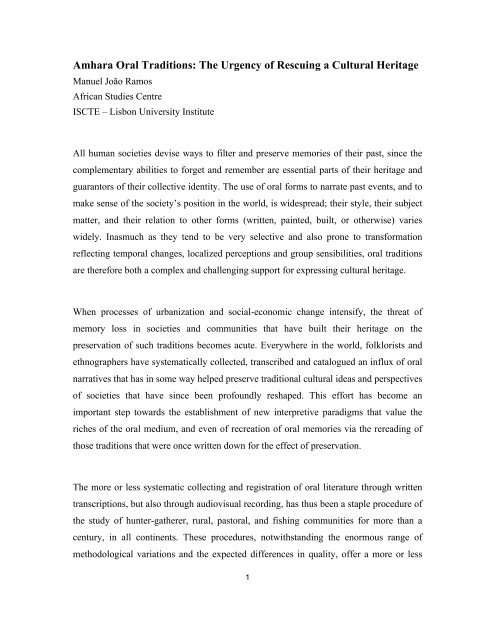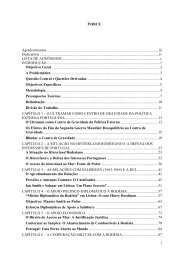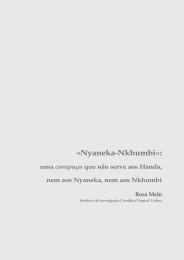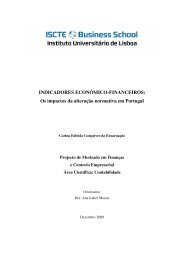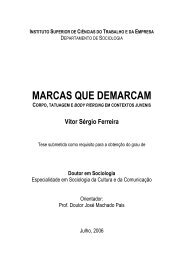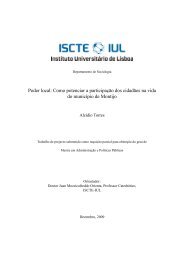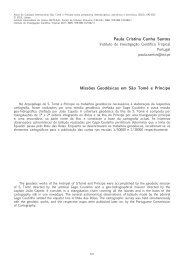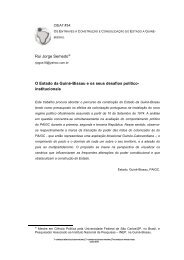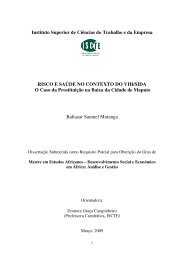Amhara Oral Traditions: The Urgency of Rescuing a Cultural Heritage
Amhara Oral Traditions: The Urgency of Rescuing a Cultural Heritage
Amhara Oral Traditions: The Urgency of Rescuing a Cultural Heritage
Create successful ePaper yourself
Turn your PDF publications into a flip-book with our unique Google optimized e-Paper software.
<strong>Amhara</strong> <strong>Oral</strong> <strong>Traditions</strong>: <strong>The</strong> <strong>Urgency</strong> <strong>of</strong> <strong>Rescuing</strong> a <strong>Cultural</strong> <strong>Heritage</strong><br />
Manuel João Ramos<br />
African Studies Centre<br />
ISCTE – Lisbon University Institute<br />
All human societies devise ways to filter and preserve memories <strong>of</strong> their past, since the<br />
complementary abilities to forget and remember are essential parts <strong>of</strong> their heritage and<br />
guarantors <strong>of</strong> their collective identity. <strong>The</strong> use <strong>of</strong> oral forms to narrate past events, and to<br />
make sense <strong>of</strong> the society’s position in the world, is widespread; their style, their subject<br />
matter, and their relation to other forms (written, painted, built, or otherwise) varies<br />
widely. Inasmuch as they tend to be very selective and also prone to transformation<br />
reflecting temporal changes, localized perceptions and group sensibilities, oral traditions<br />
are therefore both a complex and challenging support for expressing cultural heritage.<br />
When processes <strong>of</strong> urbanization and social-economic change intensify, the threat <strong>of</strong><br />
memory loss in societies and communities that have built their heritage on the<br />
preservation <strong>of</strong> such traditions becomes acute. Everywhere in the world, folklorists and<br />
ethnographers have systematically collected, transcribed and catalogued an influx <strong>of</strong> oral<br />
narratives that has in some way helped preserve traditional cultural ideas and perspectives<br />
<strong>of</strong> societies that have since been pr<strong>of</strong>oundly reshaped. This effort has become an<br />
important step towards the establishment <strong>of</strong> new interpretive paradigms that value the<br />
riches <strong>of</strong> the oral medium, and even <strong>of</strong> recreation <strong>of</strong> oral memories via the rereading <strong>of</strong><br />
those traditions that were once written down for the effect <strong>of</strong> preservation.<br />
<strong>The</strong> more or less systematic collecting and registration <strong>of</strong> oral literature through written<br />
transcriptions, but also through audiovisual recording, has thus been a staple procedure <strong>of</strong><br />
the study <strong>of</strong> hunter-gatherer, rural, pastoral, and fishing communities for more than a<br />
century, in all continents. <strong>The</strong>se procedures, notwithstanding the enormous range <strong>of</strong><br />
methodological variations and the expected differences in quality, <strong>of</strong>fer a more or less<br />
1
stable set <strong>of</strong> principles that give it the essence <strong>of</strong> a documentary corpus.<br />
As would be expected, such endeavours are not unknown in Ethiopia. But, unlike what<br />
has happened in the great majority <strong>of</strong> cases where highly rural communities in different<br />
national settings have been targeted by foreign and indigenous collectors going about<br />
their business <strong>of</strong> recording and studying oral traditions <strong>of</strong> distinct kinds, irrespective <strong>of</strong><br />
the presence or the absence <strong>of</strong> written forms <strong>of</strong> preservation <strong>of</strong> collective memory, here<br />
matters show some curious intricacies and idiosyncrasies.<br />
<strong>The</strong> overwhelming hegemony <strong>of</strong> what anthropologist Wendy James calls the Prester John<br />
myth characterising the highly cosmopolitan area <strong>of</strong> Ethiopian studies (James 1990: 134)<br />
acts as an important limiting factor for ethnographers and folklorists gathering oral<br />
histories in the country’s highland regions, the southern lowlands being a much preferred<br />
ground for this kind <strong>of</strong> research. <strong>The</strong> sad result <strong>of</strong> this biased contrast (the North as a<br />
literate environment, the South as the land <strong>of</strong> orality) is that insufficient attention has<br />
been directed toward the need for a systematic collection and study <strong>of</strong> oral traditions, and<br />
especially oral histories, in the so-called “historical” Highlands. It’s not that these<br />
traditions are unrecognized, unmentioned, and unrecorded. But they tend to be seen by<br />
researchers <strong>of</strong> different disciplines as minor productions in face <strong>of</strong> a rich, and no doubt<br />
equally selective, body <strong>of</strong> written documentation, both <strong>of</strong> indigenous and foreign<br />
provenance.<br />
Ethiopian studies are indeed a cosmopolitan regional field <strong>of</strong> research, its development<br />
bearing some similarity with Egyptian studies. What makes this field unique, within the<br />
African context at least, is that there isn’t one visibly hegemonic foreign national<br />
tradition <strong>of</strong> research influencing it. In the particular case <strong>of</strong> Ethiopia, the configuration <strong>of</strong><br />
the historical and ideological ties between the old Abyssinian Christian kingdom and the<br />
West prevented European powers from attempting a successful colonial takeover during<br />
2
the nineteenth century and concurred in Ethiopia’s own territorial extension towards the<br />
South. Consequently, national research has steered through a composite set <strong>of</strong> distinct<br />
influences that have nonetheless always converged on one point: that <strong>of</strong> a largely<br />
imaginary divide between a literate North and an illiterate South.<br />
As already mentioned, oral data have been actively gathered in the Ethiopian Highlands,<br />
mainly in a supportive role to the construction <strong>of</strong> historiographic accounts based on<br />
written and archaeological materials. It’s not rare to find instances or traces <strong>of</strong> oral<br />
inquiry in the organization <strong>of</strong> historical and literary materials, a tradition whose origins<br />
we could actually pinpoint in the vast bibliography produced by the 16 th -17 th centuries<br />
Jesuit missionaries who established themselves in Tigray and later in Gojjam and<br />
Gondar. But there has never been a systematic and integrated program <strong>of</strong> research at a<br />
regional level to build a coherent, structured, comprehensive, catalogued, indexed, and<br />
easily accessible archive <strong>of</strong> narrative oral traditions <strong>of</strong> rural and urban origin, spanning<br />
the different fields <strong>of</strong> popular belief, legendary discourse, sung poetry, etc., and covering<br />
the rich linguistic, ethnic, and religious mosaic that makes up the age-old and densely<br />
populated Ethiopian Highlands.<br />
I have, for some years now, been collecting oral legendary traditions in Gondar and<br />
Gojjam, relating to the establishment <strong>of</strong> the royal Christian court in these areas since the<br />
16 th century, as part <strong>of</strong> a loose joint project with a group <strong>of</strong> anthropologists, historians, art<br />
historians, and archaeologists concerned with the re-appreciation <strong>of</strong> the interactions<br />
between Ethiopian and European documental materials on this region and period. <strong>The</strong><br />
richness and variety <strong>of</strong> local oral legendary productions in the places that I have been<br />
visiting since 1999 has never ceased to impress me, and my feeling towards them is that<br />
each story that I hear and record is a fraction <strong>of</strong> an immense and dynamic process <strong>of</strong><br />
woven memories, or as anthropologist Claude Lévi-Strauss proposes, <strong>of</strong> a<br />
multidimensional kaleidoscope in which all parts rearrange themselves at each rotation <strong>of</strong><br />
the device.<br />
3
Likewise, my feeling is that this heritage is largely ignored, misunderstood, and<br />
undervalued by a great number <strong>of</strong><br />
people, be they researchers, administrators, and, in many cases, the keepers <strong>of</strong> the<br />
traditions themselves. Its rapport with written literary materials (namely the gaddla, the<br />
sinksars, the tariks, but also the lay historians’ accounts) is rarely subject to any<br />
functional or structural analysis, and its inner meaning lies largely dormant within a<br />
process <strong>of</strong> degradation and memory loss caused by all sorts <strong>of</strong> social, cultural, and<br />
demographic changes that the rural and urban areas have been undergoing since 1974 at<br />
least. If some <strong>of</strong> the stories and motifs are “known” beyond local and regional boundaries<br />
(the theme <strong>of</strong> the “Portuguese” builders <strong>of</strong> Gondarine royal palaces, or that <strong>of</strong> the<br />
princess sent from Rome to marry the Ethiopian king, for instance), many others tend to<br />
cause genuine surprise to many people living in urban settings and showing interest in<br />
regional historical matters. My overall perception is that, as these traditions decay and<br />
wither away, they carry with them important keys to the understanding <strong>of</strong> the history and<br />
culture <strong>of</strong> the region, resulting in a clear state <strong>of</strong> impoverishment for future generations.<br />
Hence, the present working proposal for the implementation <strong>of</strong> a plan to systematize<br />
collection and management <strong>of</strong> oral heritage for the <strong>Amhara</strong> region. This proposed plan is<br />
based on the notion that there is a rich and little known tradition <strong>of</strong> oral literature in<br />
Northern Ethiopia, and that, due to recent development that has brought about significant<br />
changes in the value <strong>of</strong> cultural heritage, that tradition is being erased at a rapid pace.<br />
Furthermore, it is assumed that most recording and documentation activities in the field<br />
<strong>of</strong> oral literature and oral history, as well as ethnomusicology, have being carried out<br />
either by foreign researchers or by Ethiopian university students and researchers, both<br />
preferring to publish the results <strong>of</strong> their activities abroad, and working in a disparate and<br />
uncoordinated way. It is also assumed that, unlike what has happened in many other<br />
countries, and even in other Ethiopian regions, systematic collections <strong>of</strong> oral traditions<br />
are nonexistent in the <strong>Amhara</strong> region, and that knowledge about oral traditions in this<br />
4
egion is very limited, scattered, unorganized, and inaccessible for most Ethiopians.<br />
CONSTITUTION OF THE TEAM<br />
<strong>The</strong> team dedicated to collecting, preserving and managing <strong>Amhara</strong> oral traditions is to<br />
be established through an agreement between <strong>Amhara</strong> Region Culture and Development<br />
Research Center (ARCDRC) at Bahir Dar University and the Bahir Dar Regional Culture<br />
Bureau, under the auspices <strong>of</strong> the Ethiopian federal Authority for Research and<br />
Conservation <strong>of</strong> National <strong>Heritage</strong>.<br />
Composition <strong>of</strong> the team:<br />
• Administrative head<br />
• Coordinator <strong>of</strong> the research<br />
• Researchers<br />
• Local assistants<br />
• Collaborators and advisors – specialists working or having worked in the field<br />
A Scientific committee, formed by recognized national and international senior<br />
researchers, will guarantee the quality and continuity <strong>of</strong> the work, supervise the various<br />
tasks, and assess the progress <strong>of</strong> the overall process. <strong>The</strong> number <strong>of</strong> available researchers<br />
will necessarily condition the duration, intensity, and scope <strong>of</strong> the collection.<br />
1 ST STEP: PRELIMINARY DOCUMENTATION PROCESS<br />
<strong>The</strong> team, in collaboration with the Scientific Committee, is to define the geographical<br />
region and cultural area where the collection <strong>of</strong> data is to be carried out. <strong>The</strong> first step is<br />
to gather information in archives and libraries – to create a database <strong>of</strong> previous<br />
collections, detailing:<br />
• Genres<br />
• <strong>The</strong>mes<br />
5
• Abstracts<br />
• Transcripts, when available<br />
<strong>The</strong> narratives <strong>of</strong> this preliminary database must indicate source, location, date, purpose,<br />
characteristics <strong>of</strong> the transcripts, and also names <strong>of</strong> the informants (this is particularly<br />
helpful for recent collections, since the informants can be contacted again for further<br />
collection by the team). A critical bibliography <strong>of</strong> previous research, as well as a list <strong>of</strong><br />
researchers, detailing their affiliation and contact information, is also crucial, since those<br />
still alive may be <strong>of</strong> help in the second stage <strong>of</strong> the research. At this stage, an effort is<br />
also to be made to collect data on genres and themes, and to copy transcripts from areas<br />
adjacent to the one to be researched.<br />
2 ND STEP: FIELD DATA COLLECTING<br />
A list <strong>of</strong> all the locations to be researched is to be drawn up, and areas distributed to the<br />
members <strong>of</strong> the team according to availability and priority. <strong>The</strong> preferred pr<strong>of</strong>ile <strong>of</strong> the<br />
informants is to be established according to each genre and theme (gender, age, position,<br />
status: i.e., man or woman, church elder, specialist singer, etc.). Note: the team must<br />
resist the temptation to rely solely or mainly on priests as informants and should look for<br />
alternative authorities (even if <strong>of</strong> low social status and position). An intensive course<br />
should be given for practical preparation <strong>of</strong> the researchers in the techniques <strong>of</strong><br />
collecting, transcribing, and editing oral traditions. This can be taught by specialists<br />
indicated by the Scientific Committee.<br />
Tools and equipment<br />
Videographic equipment should be used, depending on the genre <strong>of</strong> the materials to be<br />
collected. In any case, there should always be a redundancy system <strong>of</strong> double or even<br />
triple checking <strong>of</strong> the accuracy <strong>of</strong> the recording.<br />
6
Basic equipment:<br />
• 2 sound recording devices (tape, minidisk, or mp3 recorders)<br />
• 1 notebook<br />
Ideal equipment:<br />
• 1 video camera (miniDV)<br />
• 2 sound recording devices (tape, minidisk, or mp3 recorders)<br />
• 1 notebook<br />
• 1 digital camera<br />
Collecting tasks<br />
<strong>The</strong> use <strong>of</strong> a notebook is very important for keeping complementary information about<br />
each recording session, and for carrying out simultaneous transcription <strong>of</strong> a recorded oral<br />
tradition as a third redundancy check (to overcome data loss due to recording problems:<br />
noise, low voice, etc.). A log file for each session should be made. This is to include the<br />
name <strong>of</strong> the informant, date and place <strong>of</strong> birth, biographical information, and traditions<br />
collected (with indication <strong>of</strong> genres and themes).<br />
To spark the recall <strong>of</strong> memorized oral traditions, the researcher must be instructed to use<br />
first lines <strong>of</strong> songs, legends, etc., previously collected or previously researched (in an<br />
archive or library). References to titles, first lines, heroes, and circumstances are<br />
important mnemonic devices to spark an oral flow, be they <strong>of</strong> the same regional area,<br />
same genre and theme, or not. Authorization for divulging the collected data should be<br />
unambiguously given by the informants in writing (a proper standardized form may be<br />
produced for the use <strong>of</strong> the researchers).<br />
3 RD STEP: TRANSCRIPTION, INDEXING, AND CATALOGUING<br />
7
Transcription <strong>of</strong> recorded materials<br />
Transcription procedures are very time consuming but are a fundamental part <strong>of</strong> the<br />
project. <strong>The</strong>y permit safe storage <strong>of</strong> the original recording, and, after indexing and<br />
cataloguing, they <strong>of</strong>fer the means for study and publication <strong>of</strong> the recorded oral tradition.<br />
Indexing, cataloguing, etc.<br />
After transcription, a number <strong>of</strong> other procedures must be carried out for proper editing<br />
treatment <strong>of</strong> the collected data:<br />
• Logging - creating a log <strong>of</strong> the transcription work, in relation to the recording<br />
session file or log.<br />
• Indexing - using descriptors or keywords to describe the transcribed collected<br />
materials, by genre, theme, geographical-linguistic-ethnic area, informant, source<br />
language, version, etc.<br />
• Cataloguing - inputting, logging, and indexing data in a catalogue for subsequent<br />
searchability.<br />
• Translating - if and when possible, transcribed materials are to be translated into<br />
English for universal access.<br />
Source data are to be safeguarded according to international standards for the<br />
preservation <strong>of</strong> the recording materials, to prevent degradation, erosion, rot, and wear.<br />
Copies are to be made, preferably in digital format.<br />
4 TH STEP: INFORMATION SHARING<br />
According to the type <strong>of</strong> recording (video, sound), the kind <strong>of</strong> data (genre, theme,<br />
regional location, etc.), different interrelated sharing options may be considered. <strong>The</strong>y<br />
include:<br />
8
• Publication <strong>of</strong> catalogues<br />
• Publication <strong>of</strong> transcripts<br />
• Online availability <strong>of</strong> video and sound files, as well as transcripts and their<br />
translation<br />
• Production <strong>of</strong> DVDs and CDs<br />
• Publication <strong>of</strong> a journal or series dedicated to the diffusion <strong>of</strong> the collected data<br />
It is important to promote further data collection in adjacent and related geographical,<br />
linguistic, and ethnic areas. It is also important to establish a methodology for the proper<br />
correlation and comparison <strong>of</strong> the data by genre, theme, location, region, etc., in order to<br />
establish analytical guidelines for further study <strong>of</strong> the data by the scientific community.<br />
Returning to the field and to the published documentation to revise and refine collecting<br />
criteria, methods, and results is to be considered an integral part <strong>of</strong> the project.<br />
REFERENCES AND FURTHER READING<br />
Baum, Willa K. 1991. Transcribing and Editing <strong>Oral</strong> History. Nashville, TN: American<br />
Association for State and Local History.<br />
Benmayor, Rina, and Andor Skotnes, eds. 1994. Migration and Identity: International<br />
Yearbook <strong>of</strong> <strong>Oral</strong> History and Life Stories, Volume III. Oxford: Oxford University<br />
Press.<br />
Bertaux, Daniel, and Paul Thompson, eds. 1993. Between Generations: Family Models,<br />
Myths and Memories: International Yearbook <strong>of</strong> <strong>Oral</strong> History and Life Stories,<br />
Volume II. Oxford: Oxford University Press.<br />
9
Brown, Cynthia Stokes. 1988. Like it Was: A Complete Guide to Writing <strong>Oral</strong> History.<br />
New York: Teachers & Writers Collaborative.<br />
Dunaway, David K., and Willa K. Baum, eds. 1996. <strong>Oral</strong> History: An Interdisciplinary<br />
Anthology. 2nd edition. Nashville, TN: American Association for State and Local<br />
History.<br />
Henige, David. 1982. <strong>Oral</strong> Historiography. New York: Longman.<br />
Ives, Edward. 1980. <strong>The</strong> Tape-Recorded Interview: A Manual for Field Workers in<br />
Folklore and <strong>Oral</strong> History. Knoxville, TN: University <strong>of</strong> Tennessee Press.<br />
James, Wendy, 1990. "Kings, Commoners and the Ethnographic Imagination in Sudan<br />
and Ethiopia.” In Richard Fardon (org.), Localizing Strategies. Regional <strong>Traditions</strong> <strong>of</strong><br />
Ethnographic Writing. Edinburgh: Scottish Academic Press, pp.96-136.<br />
Jeffrey, Jaclyn, and Glenace Edwall, eds. 1994. Memory and History: Essays on<br />
Remembering and Interpreting Human Experience. Lanham, MD: University<br />
Press <strong>of</strong> America.<br />
Langer, Lawrence. 1991. Holocaust Testimonies: <strong>The</strong> Ruins <strong>of</strong> Memory. New Haven,<br />
CT: Yale University Press.<br />
Leydesdorff, Selma, Luisa Passerini, and Paul Thompson, eds. 1996. Gender and<br />
Memory: International Yearbook <strong>of</strong> <strong>Oral</strong> History and Life Stories, Volume IV.<br />
Oxford: Oxford University Press.<br />
<strong>Oral</strong> History Association. 1992. Evaluation Guidelines. Los Angeles, CA: <strong>Oral</strong><br />
HistoryAssociation.<br />
Passerini, Luisa, ed. 1992. Memory and Totalitarianism: International Yearbook <strong>of</strong><br />
10
<strong>Oral</strong>History and Life Stories, Volume I. Oxford: Oxford University Press.<br />
Perks, Robert, and Alistair Thomson, eds. 1998. <strong>The</strong> <strong>Oral</strong> History Reader. London:<br />
Routledge.<br />
Portelli, Alessandro. 1991. <strong>The</strong> Death <strong>of</strong> Luigi Trastulli and Other Stories: Form and<br />
Meaning in <strong>Oral</strong> History. Albany, NY: SUNY Press.<br />
_____ 1997. <strong>The</strong> Battle <strong>of</strong> Valle Giulia: <strong>Oral</strong> History and the Art <strong>of</strong> Dialogue. Madison,<br />
WI: University <strong>of</strong> Wisconsin Press.<br />
Powers, Willow Roberts. 2005. Transcription Techniques for the Spoken Word. Oxford:<br />
AltaMira Press.<br />
Ransel, David. 2000. Village Mothers: Three Generations <strong>of</strong> Change in Russia and<br />
Tataria. Bloomington, IN: Indiana University Press.<br />
Rogers, Kim Lacy, Selma Leydesdorff, and Graham Dawson, eds. 1999. Trauma and Life<br />
Stories: International Perspectives. Routledge Studies in Memory and Narrative.<br />
London: Routledge.<br />
Ritchie, Donald A. 1995. Doing <strong>Oral</strong> History. New York: Twayne Publishers.<br />
Terkel, Studs. 1995. Coming <strong>of</strong> Age: <strong>The</strong> Story <strong>of</strong> Our Century by Those Who've Lived It.<br />
New York: <strong>The</strong> New Press.<br />
Tonkin, Elizabeth. 1992. Narrating Our Past: <strong>The</strong> Social Construction <strong>of</strong> <strong>Oral</strong> History.<br />
Cambridge: Cambridge University Press.<br />
Vansina, Jan. 1965 [1961]. <strong>Oral</strong> Tradition. London: Routledge & Kegan Paul.<br />
11
Yow, Valerie Raleigh. 1994. Recording <strong>Oral</strong> History: A Practical Guide for Social<br />
Scientists. Walnut Grove, London, New Delhi: AltaMira Press (in association<br />
with the American Association for State and Local History).<br />
12


